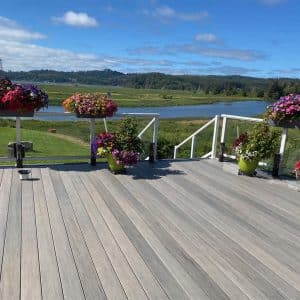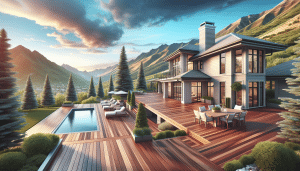Imagine a downtown rooftop that actually invites people up—warm lights, durable boards underfoot, and views of the Wasatch Range that make everyone linger. That’s commercial decking done right: utility and beauty, built to last and easy to live with. Whether you’re a contractor quoting a mixed‑use build or a homeowner converting a large patio into a rentable event space, the decisions you make about Materials, fastening, and layout matter. Let’s walk through what works here in Salt Lake, Davis, and Utah Counties—practical, a little bit poetic, and totally focused on results.
Why commercial decking is different (and why that’s a good thing)
Here’s the thing: commercial decking isn’t just a bigger porch. It has to handle heavier foot traffic, stricter codes, ADA access, and faster wear. It also has to look good for years, because customers notice. You might think longevity and style can’t coexist—but they can. With the right choices they do, and they do without constant upkeep.
In our neck of the woods—think freeze‑thaw cycles, strong sun in summer, and winter salt—material selection becomes the lead actor. For building owners, that means lifecycle costs matter more than upfront price. For contractors, it means thinking about load ratings, spacing, and warranty language before the first board goes down.
Materials that actually stand up to Utah weather
There are a bunch of options out there. Some are classic; some are modern. Each has tradeoffs. Let me explain.
Composite decking (capped)
Composite boards—especially capped composites—are the go‑to for many commercial installs. They resist staining, don’t splinter, and come in long lengths for fewer seams. You’ll pay more upfront than pressure‑treated wood, but less time (and money) on maintenance over a 10–20 year span. Contractors like them because they’re predictable to work with; DIYers like them because they feel safe barefoot—yes, really.
PVC Decking
PVC is lighter, highly stain resistant, and won’t absorb moisture. It’s great where water exposure and salt are common (think exposed rooftops). It can be pricier and may need expansion planning—boards expand and contract a bit differently than composites—so fastening details matter.
Aluminum decking
Aluminum isn’t flashy, but it’s nearly indestructible. It’s corrosion‑resistant and excellent for high‑traffic commercial walkways or pool surrounds where slipperiness is a concern. Also, it cools quicker in sun—handy on hot July afternoons.
Hardwoods (like Ipe)
Yes, hardwoods are gorgeous and they age like a fine wine—patina and all. But they need more love: oiling, checking for movement, and upfront Structural considerations. For certain high‑end restaurants or boutique hotels, hardwoods still make sense. Just know what you’re signing up for.
Design ideas that actually work (not just Instagram pretty)
Think beyond boards. You’re designing an experience: circulation, sightlines, Shade, lighting, and even sound control matter. Here are a few practical concepts that play well locally.
- Rooftop dining zones with modular planters (wind matters—use heavier substrates).
- Raised stages or performance nooks—use structural aluminum framing to reduce deflection.
- Multi‑use terraces for apartments: durable decking with integrated drainage and benching.
Want decorative inlay? Go for it. But place it where it won’t become a tripping hazard. Little details matter—rail style, fastener visibility, and transitions to interior flooring. A smooth transition makes the space feel intentional, not tacked on.
Durability, maintenance, and the money question
Okay, money talk. It’s tempting to pick the cheapest board and call it a day. But here’s a mild contradiction: sometimes spending more up front cuts costs later; other times, a modest upgrade is all you need. The trick is matching expected use with the right product and a real maintenance plan.
Ask about warranties—but also read them. Find out whether the warranty covers staining, fading, or structural failure. Ask for real references—projects in Salt Lake County or nearby where you can actually walk the deck and see how it’s performing after a few seasons.
Maintenance varies: composites usually need a quick power wash and a check for debris; hardwoods want periodic oiling; aluminum basically laughs at neglect. Fasteners matter, too—stainless Steel or coated screws, hidden‑clip systems for a clean look, and corrosion‑resistant Hardware in coastal or salt‑treated environments.
Installation tips for contractors—and curious DIYers
Structure first. You can’t fake rigging. Joist spacing, ledger flashing, and proper drainage will make or break a job. For rooftop decks, that means thinking through waterproof membranes and tie‑ins; for ground‑level commercial patios, frost depth and proper Footings are key. Codes around the Wasatch Front are specific—so is common sense.
Tools: we’re talking Impact drivers, oscillating multi‑tools for tricky cuts, and a good decking gauge for consistent spacing. Brands like DEWALT and Makita are common on job sites; stainless screws from Simpson Strong‑Tie or GRK hold up well. You know what? Good tooling saves time and money. It’s that simple.
Working with a Supplier—someone who understands commercial specs—makes quoting smoother. Want fewer callbacks? Pre‑plan expansion gaps, slope for drainage, and ask for load calculations when gigs and furniture stacks get heavy.
Final thoughts—and a little local flavor
Commercial decking in Salt Lake, Davis, and Utah Counties is about marrying practical durability with a strong sense of place. Sun on a summer night, snow underfoot in winter, patrons staying longer because the place feels solid and welcoming—those are the wins. A well‑built deck becomes part of the neighborhood fabric; a poorly built one turns into maintenance headaches and unhappy tenants.
Ready to enhance your space?
Whether you’re planning a restaurant patio, a rooftop event area, or upgrading a multi‑family property, Utah Deck Supply is here to help with materials, advice, and real local experience. Call us at 385‑993‑5492 or Request a Free Quote to get started. Honest talk, sensible options, and decks that last—sounds good, right?




